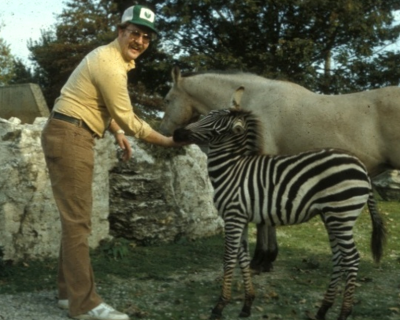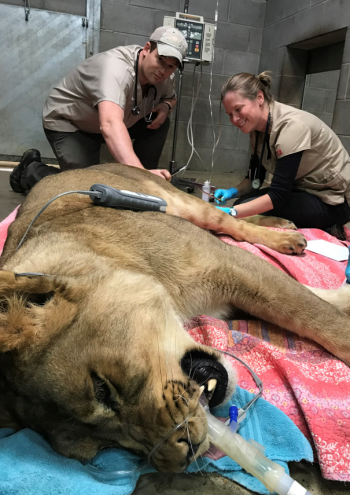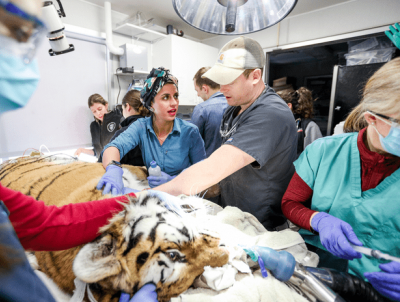A clerkship in the Zoo and Wildlife Medicine Program may sound like a fun, out-of-the-box learning experience—and it is—but more than that, it’s an essential stepping stone to a career that impacts conservation, public health, and veterinary care for animals beyond the typical dog and cat.
The roots of MSU’s Zoo and Wildlife Medicine Program trace back to the vision and dedication of several faculty members. Dr. Spencer Newman, the founding veterinarian of the program, became interested in the field after volunteering at the Detroit Zoo Hospital most weekends as an undergraduate student. After his admission to the College of Veterinary Medicine, his interests came to the attention of Dr. Hyram Kitchen, a faculty member who cared for the animals at the Detroit Zoo and Potter Park Zoo. Kitchen began taking Newman on calls to these zoos, and by the time Newman was preparing to graduate, he had an offer from Kitchen for a faculty appointment as an instructor in zoological and wildlife medicine.
“Dr. Kitchen's mentoring of me both before and after my graduation was an ever-present benefit for which I am eternally grateful,” says Newman. During his year establishing the program, Newman built a relevant library, designed a course for students, and served as the veterinarian for Potter Park Zoo. After a year at MSU, Newman left to enter private practice in Georgia, and Dr. Jim Sikarskie took over the program.

“I feel I was very lucky being in the right place at the right time to get what I considered the opportunity of a lifetime right out of veterinary school,” says Sikarskie. “I was very influenced by the first Earth Day in 1970 when it was predicted there would be no birds of prey left by the year 2000 if we did not do something to save the environment. That is part of what motivated me to pursue wildlife veterinary medicine.”
Sikarskie built upon Newman’s foundation, working to give students more of the training and experience he wished he’d had as a student. “I started off taking students to the zoo with me for hands-on experience and eventually developed my own elective rotation in Zoo and Wildlife Medicine, Management, and Pathology,” says Sikarskie. “I was only supposed to have the position for one year to make sure the role did not lose the funding, but I must have done something right because I stayed for 44 years!”

After Sikarskie retired in 2019, Drs. Tara Harrison and Sally Nofs (both professors) led the program for a couple of years before the College enlisted two adjunct faculty members: Dr. Ronan Eustace and Dr. Kimberly Thompson, a married couple who are both diplomates of the American College of Zoological Medicine. Recently, the pair has been officially brought on as assistant professors to expand the program and its offerings.
They’ve already begun this work by participating in the College’s summer research program, in which Eustace and Thompson each take on a student to mentor. This opportunity gives the selected students valuable clinical experience, often culminating in a presentation at an international zoo medicine conference. Previous students have done research on topics ranging from neonatal giraffe hematology ranges, thyroid disease in red pandas, and antifungal resistance in penguins with aspergillosis. The pair is also continuing to offer the zoo and wildlife medicine clerkship, which exposes the students daily to cases at both Binder Park Zoo and Potter Park Zoo. “The range of experience we can provide the students is highly varied and not something that could be offered right on the school campus,” says Thompson. “It’s brought on a whole new aspect of diversity to the students’ learning.”
“It’s a mutually beneficial relationship,” adds Eustace. “In bringing the students to the zoos, we’re bringing a broad mix of people with different backgrounds and experiences. And the students are learning new skills and being forced to think outside the box because they’re seeing a new species or a disease they’ve never heard of before.”

While the program has certainly evolved from its early days, Eustace and Thompson are eager to continue its growth. They are actively seeking support to enhance the program and create more learning opportunities through:
- A wildlife ward, which would provide a place for students to incorporate wildlife care into their daily clinical learning.
- A residency to offer advanced training in zoo and wildlife medicine, as well as public health work.
- Research funds to advance critical studies in animal health, conservation, public safety, and innovative treatments that will benefit wild and domesticated animals, as well as humans, worldwide.
If you are interested in supporting any of these initiatives, please reach out to development@cvm.msu.edu
Today, with its expanded offerings and ongoing growth, the program stands as a testament to the hard work of its faculty and the bright future it holds for the next generation of veterinarians.
